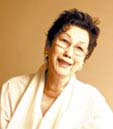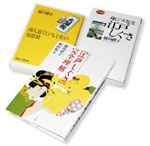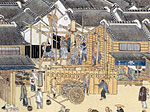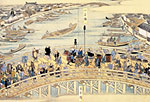|
|
|
|
|
||||||||||
HOME > the spirit of the brabd nihonbashi-bijin > Yuu:Edo-Shigusa Cultural Enrichment Ms. Reiko Koshigawa Leader of the Edo-Shigusa Narrators'Group
An aptitude for considering other people ユs feelings is the charm of Nihonbashi-bijin ムJapan Beauty from Edo-Tokyo. Now Edo-shigusa, the manners and behaviors established by the leaders of Edo, has gradually become the topic of conversation. The reason for that is because people are pursuing in natural beauty derived from the consideration and respect for others. Well-educated women of sophistication shine. So we asked Ms. Reiko Koshigawa, the recognized authority on Edo-Shigusa, about the elegant sophistication of people in Edo underlying the value of the Nihonbashi-bijin brand.
Edo-Shigusa Cultural Enrichment for Nihonbashi-bijin

Ms. Reiko Koshigawa
Leader of the Edo-Shigusa Narrators'Group
Leader of the Edo-Shigusa Narrators'Group

The big city of Edo and its merchants
Tokugawa Ieyasu (1543-1616), the first shogun of the Tokugawa shogunate, presumed that Edo would be a central commercial city rich in fish because it faced the sea and had clean water. He then conducted various projects taking three years to establish the capital city in Edo. Among them, I think it was a unique idea that he had a thousand merchants who were loyal to the shogunate move to Edo. Those merchants split and provided the logistical support for development of the city.
Marine transport supported the city functions of Edo and products from all over Japan carried by large ships were transferred to small boats and delivered to places within Edo.
Merchants used this marine shipment system to carry building materials and labor from all over Japan. They were also said to even secure housing for those people and supply food like a caterer.
Edo merchants valued confidence by making good on their promises. Such confidence apparently was the origin of the “official merchants to the shogunate.” Ieyasu was so far-sighted that he knew that only merchants with rich experience, a head for business, and who could deal with people equally would be able to lead people to develop the city of Edo.
Tokugawa Ieyasu (1543-1616), the first shogun of the Tokugawa shogunate, presumed that Edo would be a central commercial city rich in fish because it faced the sea and had clean water. He then conducted various projects taking three years to establish the capital city in Edo. Among them, I think it was a unique idea that he had a thousand merchants who were loyal to the shogunate move to Edo. Those merchants split and provided the logistical support for development of the city.
Marine transport supported the city functions of Edo and products from all over Japan carried by large ships were transferred to small boats and delivered to places within Edo.
Merchants used this marine shipment system to carry building materials and labor from all over Japan. They were also said to even secure housing for those people and supply food like a caterer.
Edo merchants valued confidence by making good on their promises. Such confidence apparently was the origin of the “official merchants to the shogunate.” Ieyasu was so far-sighted that he knew that only merchants with rich experience, a head for business, and who could deal with people equally would be able to lead people to develop the city of Edo.
 People valued harmony during house construction as well.
People valued harmony during house construction as well.Edo-shigusa fostered by “koh”
After the birth of the city Edo with a million residents, the shogunate gave people autonomy for their own towns. People came up with ways to live comfortably and respect each other in a big city where the population was concentrated. They made their own rules and developed manners and behaviors to achieve a unique lifestyle, which was the origin of “Edo-shigusa.”
“Koh” was the place where people actually learned Edo-shigusa. They gathered to discuss solutions to the task for each session and invited a lecturer when necessary. When a new house was built, they were said to have discussions to decide the color of the building's roof tiles so that they would go well with the scenery of their town. Here you can see another example of the spirit of Edo-shigusa, where they believed that houses were not the possession of the dwellers but something possessed by the people living in the town.
After the birth of the city Edo with a million residents, the shogunate gave people autonomy for their own towns. People came up with ways to live comfortably and respect each other in a big city where the population was concentrated. They made their own rules and developed manners and behaviors to achieve a unique lifestyle, which was the origin of “Edo-shigusa.”
“Koh” was the place where people actually learned Edo-shigusa. They gathered to discuss solutions to the task for each session and invited a lecturer when necessary. When a new house was built, they were said to have discussions to decide the color of the building's roof tiles so that they would go well with the scenery of their town. Here you can see another example of the spirit of Edo-shigusa, where they believed that houses were not the possession of the dwellers but something possessed by the people living in the town.
 Rivers in Edo were the main arteries of logistics.
Rivers in Edo were the main arteries of logistics.Source: Berlin East Asian Art Museum
From Nihonbashi in Kidai Shoran, co-written by Hiroshi Ozawa and Tadashi Kobayashi
Software that supported the city
People of Edo with Edo-shigusa took pride in themselves and had a sense of decency. They wore linen sandals on the streets to walk quietly, and plants at the door of houses were always trimmed by the landlords. Gravel on the temple grounds were polished so clean that people could walk there barefoot or wearing only tabi socks. There were such customs as to put up a notice on a house stating that they had a sick person so that traveling salespeople would lower their voice, and residents asked for their neighbors' permission before making a fire.
Townspeople maintained the safety of their areas by establishing a neighborhood watch system. Hi-no-yojin (fire prevention) night watch and other customs still in existence today are a vestige of this system. The city of Edo had fires so frequently that they were called Edo-no-hana (Edo's attraction), and one of the valued ideas of Edo-shigusa was not to cause a fire from the same cause.
They also had a rule that, when there were many stores in the same trade close to each other, any one store was open everyday. This was conducted not only for the convenience of customers but also in order for stores to work together for mutual harmony and benefit by sharing the business. The basis of Edo-shigusa was wisdom to create communities where people could live together by avoiding excessive competition and helping each other. If the city were hardware, Edo-shigusa would be the software essential for the hardware to work well.
People of Edo with Edo-shigusa took pride in themselves and had a sense of decency. They wore linen sandals on the streets to walk quietly, and plants at the door of houses were always trimmed by the landlords. Gravel on the temple grounds were polished so clean that people could walk there barefoot or wearing only tabi socks. There were such customs as to put up a notice on a house stating that they had a sick person so that traveling salespeople would lower their voice, and residents asked for their neighbors' permission before making a fire.
Townspeople maintained the safety of their areas by establishing a neighborhood watch system. Hi-no-yojin (fire prevention) night watch and other customs still in existence today are a vestige of this system. The city of Edo had fires so frequently that they were called Edo-no-hana (Edo's attraction), and one of the valued ideas of Edo-shigusa was not to cause a fire from the same cause.
They also had a rule that, when there were many stores in the same trade close to each other, any one store was open everyday. This was conducted not only for the convenience of customers but also in order for stores to work together for mutual harmony and benefit by sharing the business. The basis of Edo-shigusa was wisdom to create communities where people could live together by avoiding excessive competition and helping each other. If the city were hardware, Edo-shigusa would be the software essential for the hardware to work well.
|



